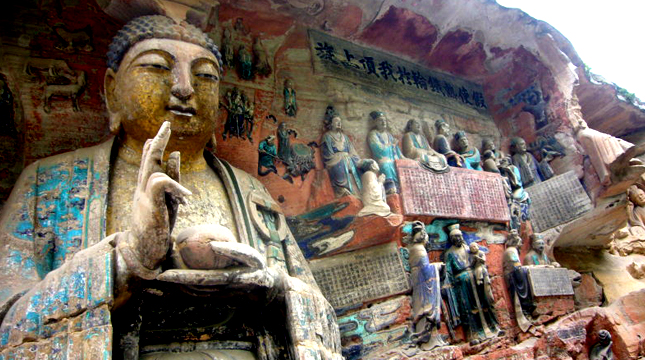Blue Cliff Record, Case 18
Emperor Su Tsung asked National Teacher Hui Chung, “After you die, what will you need?”
The National Teacher said, “Build a seamless monument for me.”
The Emperor said, “Please tell me, Master, what the monument would look like?”
The National Teacher was silent for a long time; then he asked, “Do you understand?”
The Emperor said “I don’t understand”
The National Teacher said, I have a disciple to whom I have transmitted the Teaching, Tan Yuan, who is well versed in this matter. Please summon him and ask him about it.”
After the National Teacher passed on, the Emperor summoned Tan Yuan and asked him what the meaning of this was. Tan Yuan said:
South of Hsiang, north of T’an;
(Hsueh Tou added the comment, “A single hand does not make random sound.”)
In between there’s gold sufficient to a nation.
(Hsueh Tou added the comment, “A rough-hewn staff.”)
Beneath the shadowless tree, the community ferryboat;
(Hsueh Tou added the comment, “The sea is calm, the rivers are clear.”)
Within the crystal palace, there’s no one who knows.”
(Hsueh Tou added the comment, “He has raised it up.”)
Notes and Reflections
Definition of the word “seam.”
Seam. n. 1. a. A line or junction formed by sewing together two pieces of material along their margins. b. A similar line, ridge, or groove made by fitting, joining, or lapping together two sections along their edges. c. A suture. d. A scar. 2. Any line across a surface, as a crack, fissure, or wrinkle. 3. A thin layer or stratum, as of coal or rock. —v. seamed, seaming, seams. —tr. 1. To put together with or as with a seam. 2. To mark with a groove, wrinkle, scar, or other seamlike line. —intr. To crack open; become fissured or furrowed.
So a seam can be seen as that which connects two pieces, or that which separates two pieces. It could be a demarcation point between two pieces. A seam has the function of connection and separation at the same time. Therefore “seamless” neither connects nor separates.
With this in mind, it seems (pardon the pun) the National Teacher Hui Chung asks for a monument which neither connects nor separates. Or is one and not two. Or is not one not two. Is he asking for an empty tomb? Empty so that they could put his body in it? Or is he saying he doesn’t want anything? That he doesn’t want a monument. That he doesn’t want any fanfare made at his burial. This last suggestion seems unlikely, though, because according to the commentary in the text of the Record, the student, Tan Yuan, whom the National Teacher asked the Emperor to summon to the court, was critical of Hui Chung’s enjoyment of the benefits associated with royalty—of being “addicted to fame and fortune, and for liking the company of people.” On the other hand, the next sentences of the koan point to this ‘empty’ direction.
The Emperor said, “Please tell me, Master, what the monument would look like?”
The National Teacher was silent for a long time; then he asked, “Do you understand?”
The silence, it seems to me, is another metaphor for the seamless monument. Silence is a metaphor for emptiness. Of nothing there.
The Emperor said, “I don’t understand.”
He didn’t know what National Teacher Hui Chung is talking about. So the National Teacher tells him to fetch his disciple, Tan Yuan for he is “well versed in this matter.”
What is “this matter?”
It is interesting that the koan then skips to the death of the National Teacher. What happened? Was Tan Yuan summoned to court? If so, why didn’t he come? Because of his criticism of Hui Chung? Was the exchange of the koan made at the deathbed of Hui Chung? And why did the emperor wait for the death of the National Teacher before summoning Tan Yuan? Why didn’t he call Tan Yuan immediately so that he could be with his teacher before his death?
Well, at any rate, finally Tan Yuan made his reluctant appearance before the Emperor who asked him what the hell was his teacher talking about? What is a seamless monument? Why didn’t he answer my question but just stood dumb with his mouth shut tight? And Tan Yuan recites a poem:
South of Hsiang, north of Tan;
In between there’s gold sufficient to a nation.
Beneath the shadowless tree,
the community ferryboat;
within the crystal palace,
there’s no one who knows.
Katsuki Sekida, in his notes on the koan, says that the first line of the poem is equivalent to saying South of the North Pole and North of the South Pole. In other words the entire boundaries of the earth. Hsiang and Tan are two rivers. One North, one South, and they mark the boundaries of China, and in between the rivers you can find all the gold you need to run the nation. Gold, according to Sekida, is Chan which at that time was the most prominent of the three religions: Ch’an, Confucianism, and Taoism. Supporting evidence of this is the fact that Hui Chung was the National Teacher and a favorite at court. There was a lot of jealousy about the deference he received from the Emperor from monks and priests of the other two religions, especially since Confucianism and Taoism were both indigenous Chinese religions, whereas Buddhism was an imported barbarian religion.
The third line of the poem contains the shadowless tree and the ferryboat.
Beneath the shadowless tree,
the community ferryboat;
The ferryboat, says Sekida, is used to carry people across to the other side. Sound familiar? Is this a reference to the mantra of the “Heart Sutra?”
Gate, Gate, Paragate, Parasamgate, Bodhi Svaha.
The shadowless tree, according to Sekida, symbolizes eternity.
So one can say that the Chan which existed in China in those days changed people’s lives forever. This is what the mantra of the Heart Sutra declaims. This is a mantra of transformation. This is a mantra of the transcendental. That which moves from the relative to the absolute. That which transforms form into emptiness. That which is seamless.
Again we are in the “Heart Sutra.” Transcending or transformation is not transcending or transformation. One does not change from being a ‘bad’ person to being a ‘good’ person. One does not become better. There is no better for there is no other side. There is no getting from here to there for there is no there—there is only here. And there is no ferryboat! Transformation in Zen is not transformation. Again the “Heart Sutra.”
No old age or death,
no suffering,
no cause, or end to suffering.
No path,
no wisdom,
no gain.
No mind,
no thing,
no Buddha
and no transformation.
Nothing happens on this no path. No transformation but everything is different. And everything is the same. You all know the old cliché about the beginning Zen student who sees mountains as mountains, rivers as rivers, roses as roses, and stars as stars. Later, as she progresses in her practice, and begins to experience some insights, she realizes that mountains are not mountains, rivers are not rivers, roses are not roses, and stars are not stars. But finally, when she is enlightened, she knows and sees mountains as mountains, rivers as rivers, roses as roses, and stars as stars. But the third stage and the first stage are not the same! The third stage is completely different. For in the first stage you are in the state of Duhkha. The second stage is transitional and leads to transformation— o enlightenment. The third stage is the stage of redemption. It is like the first stage, but it is Duhkha redeemed. It is Paradise Reborn.
So the poem could be telling us that the seamless monument that National Teacher Hui Chung wants is simply Chan.
***
Emperor Su Tsung asked National Teacher Hui Chung, “After you die, what will you need?”
The National Teacher said, “Build a seamless monument for me.”
The Emperor said, “Please tell me, Master, what the monument would look like?”
The National Teacher was silent for a long time; then he asked, “Do you understand?”
The Emperor said “I don’t understand”
The National Teacher said, I have a disciple to whom I have transmitted the Teaching, Tan Yuan, who is well versed in this matter. Please summon him and ask him about it.”
After the National Teacher passed on, the Emperor summoned Tan Yuan and asked him what the meaning of this was. Tan Yuan said,
South of Hsiang, north of T’an;
In between there’s gold sufficient to a nation.
Beneath the shadowless tree,
the community ferryboat;
Within the crystal palace,
there’s no one who knows.”



